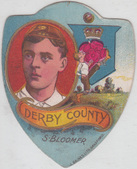
1aSteve Bloomer (ENG)
1900s Baines Shield.
Steve Bloomer was a prolific goal scorer for both club and country, and is generally considered the best player of this era. Between 1892 and 1914, he scored 352 goals in 598 matches for Derby County and Middlesbrough. That puts him second all-time for top-flight career goals in England. Bloomer led England to 8 British Home Championships (the tournament among the four British home countries). “Steve Bloomer's Watchin” is played before the start of every Derby County homes game in his honor.
| 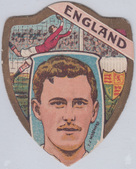
1bVivian Woodward (ENG)
1900s Baines Shield.
Vivian Woodward was G.O. Smith’s successor as center-forward on the English national team. He captained the team at both the 1908 and 1912 Olympics, with England winning the gold medal at both tournaments. Woodward's tally of 29 goals in 23 matches for England remained a record from 1911 to 1958. He also netted 103 goals in 238 English league appearances.
| 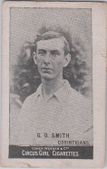
1cG.O. Smith (ENG)
1897 Circus Girl.
Gilbert Oswald “G.O.” Smith is considered the first great center forward and was perhaps the most admired figure in the English game at the time of his retirement. He was familiarly known to several generations of schoolboys simply by his initials. Between 1893 and 1901, Smith played 20 games for the English national team, scoring 11 times. This included at least 13 appearances as England’s captain. Playing for the Corinthians, Smith scored 132 goals in 137 matches which remains one of the best strike rates in the history of the game. His record for The Casuals was even more impressive, scoring 42 goals in 29 matches.
|

1dJimmy Quinn (SCO)
1908 F & J Smith.
Jimmy Quinn was a prolific scorer, scoring 187 league goals the second highest total in Scottish Football League. Playing for Celtic, he won six successive championships and five Scottish Cup medals. Quinn scored 7 goals in 11 appearances for Scotland.
| 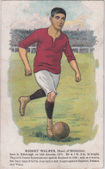
1eBobby Walker (SCO)
1902 Herriot Series Postcard.
The Football Encyclopedia from 1934, edited by Frank Johnston, referred to Bobby Walker simply as "Bobby Walker, the greatest natural footballer who ever played." The great inside forward and playmaker scored 311 goals in 461 appearances for Scottish club Heart of Midlothian. Walker was capped 29 times (a record at the time) between 1900 and 1913.
| 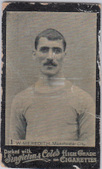
1fBilly Meredith (WAL)
1905 Singleton & Cole.
The Welsh superstar Billy Meredith played from 1892 to 1924, primarily for Manchester City and Manchester United, retiring at the age of 47! In 1904, he captained Manchester City to the club’s first major honor, a win in the 1904 FA Cup Final. With Manchester United, Meredith won league titles in 1908 and 1911 and the FA Cup in 1909. Meredith was instrumental in organizing the first players’ union.
|
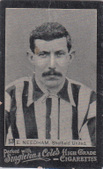
1gErnest Needham (ENG)
1905 Singleton & Cole.
Ernest Needham was an industrious and cerebral half back who played for Newcastle United from 1891 until 1910. He captained the tem for 10 years and, under his captaincy, Newcastle won a league title in 1898 and the FA Cup in 1899 and 1902. The “box-to-box” midfielder was capped 16 times by the English national team.
| 
1hAlex Raisbeck (SCO)
1906 R & J Hill.
Center-half Alex Raisbeck played for Liverpool from 1989 to 1909. As Liverpool’s captain, he led the club to league titles in 1901 and 1906. Raisbeck won 8 caps for Scotland and captained the national team on 5 occasions.
| 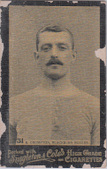
1iBob Crompton (ENG)
1905 Singleton & Cole.
Arguably the best defender of his era, Bob Crompton spent his entire career as a full-back for the Blackburn Rovers, playing 528 games between 1896 and 1920. He captained the club to league titles in 1912 and 1914. Crompton represented the English national team on 41 occasions, a record not broken until 1952, and captaining the team 22 times.
|

1jHoward Spencer (ENG)
1905 Cohen, Weenen Actresses, Footballers & Jockeys.
Considered one of Aston Villa’s all-time greatest players, Howard Spencer was a world-class defender, earning him the nickname “Prince of Full-Backs.” He was instrumental in Aton Villa winning four League Championships in 1896, 1897, 1899 and 1900 and reaching three FA Cup finals. With Spencer, Aston Villa won The Double in 1896-97 season.
| 
1kLeigh Richmond Roose (WAL)
1909 Smith.
The best goalkeeper of the 1900s, L.R. Roose was also quite eccentric and entertaining. During a game he could usually be found leaning casually against the goal post without a care in the world, as if he was waiting for a bus. He once stopped a line-drive goal from just six yards away by catching the ball between his knees. Roose led a successful career for Stoke, Everton and Sunderland including 40 clean sheets for Stoke in just a three-year period. Because of Roose, the Football Association changed the rule that previously allowed goalkeepers to carry the ball to midfield. Roose had such a tremendous kick and long throw that he could easily put the ball in the opposition's penalty area from midfield.
| 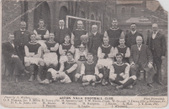
1lGeorge Ramsay (SCO)
1905 Postcard.
George Ramsay was the world’s first ever appointed, paid football manager. As manager/secretary, he oversaw Aston Villa’s “Golden Age”. The great Scot led his teams to an astonishing six league titles and six FA Cups between 1893 and 1920. Ramsay’s overall managerial win percentage in the Premier League/First Division ranks ninth all-time.
|

2aRobert Hamilton (SCO)
1902 Ogden’s "General Interest".
The Glasgow Rangers’ top scorer for nine consecutive seasons from 1897 to 1906, Robert “R.C.” Hamilton led the club to league titles in 1900, 1901 and 1902. In the 1898-99 season, the Rangers went undefeated with Hamilton as their captain. He was capped 11 times between 1899 and 1911, scoring 15 goals for Scotland.
| 
2b Fred Wheldon (ENG)
1900 Cohen Weenen.
“Diamond" Freddie Wheldon was a member of the Aston Villa team that dominated the late 1890s, winning four league titles in 1896, 1897, 1899 and 1900. That team included Wheldon, Charlie Athersmith, Jimmy Crabtree, Howard Spencer and John Campbell. Wheldon was the club’s top scorer in the 1895-96 season and the league’s leading scorer in the following season. He was known for his command of the ball and his adaptability to prevailing conditions, combined with his dodging, his swerving, and his deadly shooting. Wheldon was also a world-class cricketer.
| 
2cAlbert Shephard (ENG)
1906 John Sinclair Cigarettes.
Albert Shepherd was Newcastle’s first superstar. He scored 92 goals in 123 appearances for the club, winning the league scoring title in both the 1905-06 and 1910-11 seasons. Shepherd scored 90 goals in 123 for the Bolton Wanderers. He known for having a ferocious shot which on some occasions even carried the goalkeeper over the line as well as the ball.
|

2dJohn Goodall (ENG)
1900 Ogden’s.
John Goodall was a member of the original “Invincibles,” the 1889-90 Preston North End team that went unbeaten during the season and won the FA Cup without conceding a goal. Goodall was the league’s top scoring that season, scoring 21 goals in 21 matches. Between 1888 and 1898, Goodall won 14 caps for the English national team, scoring 12 goals. Like Fred Wheldon, Goodall was also a world-class cricketer.
| 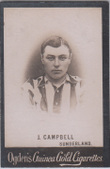
2eJohn Campbell (SCO)
1897 Ogden’s Guinea Gold.
Scottish center forward John Campbell was English football’s truly prolific goal scorer and the best footballer in the world from 1892 to 1897. Campbell led Sunderland to three league titles in 1892, 1893 and 1895 and was the English league’s top scorer in all three seasons. In all, he made 186 league appearances for Sunderland and scored 133 goals. Later, he helped Newcastle be promoted to First Division for the first time.
| 
2fCharlie Athersmith (ENG)
1896 Phillips.
Playing outside-right, William “Charlie” Athersmith was said to be the speediest striker in England. He led Aston Villa to five league titles in 1894, 1896, 1897, 1899 and 1900 as well as three F A cup finals. In 1901, Villa was playing in the freezing rain. Athersmith had had enough and borrowed an umbrella from a spectator. Athersmith played with umbrella in hand and even went on to score while holding it.
|
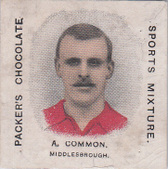
2gAlf Common (ENG)
1909 Packer's Chocolate.
Alf Common was the first four-figure player. In 1905, Common broke the transfer record by moving to Middlesbrough for £1,000. Middlesbrough acquired Common in an attempt to prevent being relegated to Second Division. The plan worked, Common led the club with 58 goals over the next several seasons and the team avoided relegation.
| 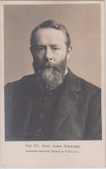
2hArthur Kinnaird (ENG)
c1905 Postcard.
An early pioneer of the game and later FA Association President for 30 years, Arthur Kinnaird was one of the winningest players ever. Lord Kinnaird won three FA Cups with the Wanderers and two more with the Old Etonians, reaching the FA Cup finals a record nine times. As a Cup Final player, Kinnaird played in every position, from goalkeeper to forward. But his primary position was right-half. He was known as the toughest tackler of his day. The story goes that his wife once expressed the fear that he would “come home one day with a broken leg.” A friend is said to have responded, “You must not worry, madam. If he does, it will not be his own.”
| 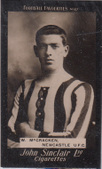
2iBilly McCracken (IRE)
1906 John Sinclair.
One of the best defenders of his era, North Irishman Billy McCracken played right back for Newcastle from 1904 to 1924. He helped the club win league titles in 1905, 1907 and 1909 as well as the 1910 FA Cup. McCracken was so adept at catching the opposing teams’ forwards offside that he forced a change in the rules of the game.
|
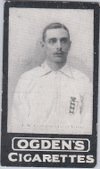
2jJimmy Crabtree (ENG)
1900 Ogden’s.
Left- half Jimmy Crabtree was considered one of England’s greatest footballers. He played let-half for Aston Villa, opposite Howard Spencer in Villa’s backfield, and helped the club win four league titles between 1896 and 1900 as well as an FA Cup in 1897. He won 11 caps for the English national team between 1894 and 1902.
| 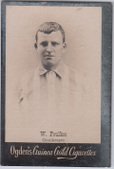
2kFatty Foulke (ENG)
1897 Odgen's Guinea Gold.
William “Fatty” Foulke is a legend. He stood 6’4” and at retirement weighed 336 pounds (or 24 stones as they used to say). When asked about his nickname, Foulke once replied, "I don't mind what they call me as long as they don't call me late for my lunch." With Sheffield United, Foulke won a league title in 1898 (runner-up in both 1897 and 1900) and won the FA Cup in 1899 and 1902 (runner-up in 1901). Sheffield was considered the best defensive team in the league, with Fouke conceding just 29 goals in the 1896-87 season. Foulke could kick the ball the length of the field and it was said that he could punch the ball as far as some players could kick it. He was known for pulling down on the crossbar to give a high shot a marginally smaller target; on more than one occasion, he accidentally broke the crossbar in this manner. Foulke was also remarkably temperamental. If he thought his defenders were not tryi...
| 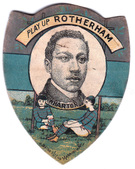
3aArthur Wharton (GHA/ENG)
c1893 J. Baines & Son Shield.
The first black professional sportsman to play in England, goalkeeper Arthur Wharton was selected to the prestigious “Newcastle and District” team while at Darlington. His reputation caused Preston North End to sign him for the 1886-87 season as the club transformed itself into “The Invincibles”. In the late 1890s Wharton coached the Stalybridge Rovers and in 1896 he signed the great future manager Hubert Chapman. The Ghanaian-born Wharton was perhaps the epitome of the all-round Victorian sportsman: he held the world record for the 100m dash - at 10 seconds flat, played professional cricket and football. He did all this in a time where racism was rife.
|

3bBilly Bassett (ENG)
1896 Phillips "General Interest".
Billy Bassett played outside-right for West Bromwich Albion from 1886 to 1899. He played 261 league games for the club, scoring 61 goals. He also won 16 caps for the English national team and scored 8 goals, becoming one of the game's earliest celebrities. In 1894, Bassett became the first ever Albion player to be sent off; he was dismissed for using "unparliamentary language.” When Bassett died in 1937, more than 100,000 people lined the streets of West Bromwich for his funeral procession.
| 
3cBert Freeman (ENG
1908 F & J Smith.
English center forward Bert Freeman scored an impressive 200 goals in 321 league appearances between 1904 and 1922. He was a key player in helping Burnley win the FA Cup final in 1914. He was capped five times by England and was a member of the wining sides of the 1909 and 1912 British Home Championships.
| 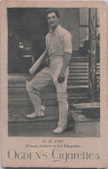
3dC.B. Fry, C.B. (ENG)
1897 Ogden’s.
Even better known for hi cricket success, Charles Burgess (“C.B.”) Fry was a defender with exceptional pace. The right-back played at both Oxford and the Corinthians with legendary center-forward G.O. Smith. Unlike Smith, Fry eventually turned professional to enhance his chance of international honors. His plan worked. After helping lead Southhampton to win the Southern League title in the 1900-01 season, Fry was named to the England national team.
|
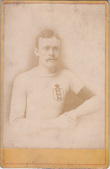
3eFrank Heron (ENG)
1870s CDV.
The English national team’s fourth-ever captain, Francis (Frank) Heron captained the team in England’s fifth international match, a 0-3 defeat at the hand of Scotland in 1876. Playing for the Wanderers, Heron starred in the 1876 FA Cup final, scoring two crucial goals against Sheffield in the third round of the tournament. In the final, the Wanderers defeated the Old Etonians.
| 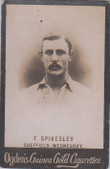
3fFred Spiksley (ENG)
1897 Ogden's Guinea Gold.
English forward Fred Spiksley enjoyed great success playing for Gainsborough Trinity, scoring 131 goals in 126 matches and leading the club to a Double in 1889 by winning both the Lincolnshire F.A. Cup and the Gainsborough News Charity Cup. Upon signing for Sheffield Wednesday, he scored 100 goals in 293 league matches and 14 goals in 28 FA Cup appearances. As a coach, Spiksley won national league titles in Sweden, Mexico and Germany.
| 
3gAlex Smith (SCO)
1902 J&F Bell "Three Nuns".
Scottish winger Alex Smith spent 21 seasons with the Glasgow Rangers, during which time the club won 7 Scottish Championships, including 4 consecutive championships between 1898 and 1902. Smith was also capped 20 times by Scotland during his career.
|

3hCharlie Roberts (ENG)
1914 Churchman’s.
Arguably the best center-half in Europe in the early 20th Century, Charlie Roberts starred for Manchester United and helped the club win league titles in 1908 and 1911 and the FA Cup in 1909. He and Billy Meredith were instrumental in establishing the Players Union which unionized professional footballers. Roberts also had a reputation for mocking the FA rules by wearing his shorts above the knee. Both of these actions contributed to Roberts being called up to the national side just a few times. When Roberts was transferred to Oldham Athletic in 1913, the transfer fee was a then-world record of £1,500.
| 
3iAndy Aitken (SCO)
1902 J&F Bell.
One of the best halfbacks of his era, Scot Andy Aitken was a key to Newcastle United’s success at the turn of the century. With Aitken, Newcastle won the League Championship in 1905 and appeared in the FA Cup Finals in both 1905 and 1906. He was capped 14 times by Scotland.
| 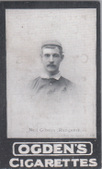
3jNeilly Gibson (SCO)
1901 Ogden’s.
Neilly Gibson was a legendary halfback with the Glasgow Rangers, winning 4 league titles and 3 Scottish Cups between 1897 and 1903. Capped 14 times by scotland, Steve Bloomer described him as "The greatest footballer I ever saw.”
|

3kJames Cowan (SCO)
1900 Cohen Weenen.
Considered one of the finest footballers of the Victorian Era, Scottish half-back James Cowan spent 14 seasons with Aston Villa. He led the club to five First Division titles and two FA Cups. Due to a ban by Scotland on players on English Clubs, Cowan was not capped until 1896. In that year, Cowan played for the Scottish side that beat England to end its 6-year unbeaten run.
| 
3lWilliam Oakley (ENG)
1900 Ogden’s.
The best left-back in the world during the 1890s, William Oakley played for the renowned amateur clubs, the Corinthians and the Casuals. Between 1895 and 1901, Oakley was capped 16 times by the England and served as captain of the national team on one occasion. He was close friends with Corinthians teammates G.O. Smith.
| 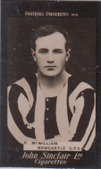
3mPeter McWilliam (SCO)
1906 John Sinclair Cigarettes.
Scottish midfielder Peter McWilliam was a key member of the Newcastle United side that won 3 Football League titles, 1 FA Cup and was FA Cup-runner up on 3 occasions between 1905 and 1910. Following his playing career, McWilliam would enjoy a lengthy managerial career, including 19 years at Tottenham where he pioneered the use of “feeder clubs” to give his younger players plying time.
|

3nJimmy McMenemy (SCO)
1908 Smith’s Cup Ties.
Scottish forward Jimmy McMenemy was a member of the Celtic side that won 6 consecutive league titles between 1904 and 1910. During his 18 years with the club, he scored 144 goals.
| 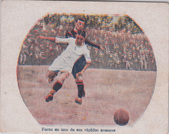
3oRomà Forns (CAT)
1915 Chocolate Amatller.
Roma Forns debuted at Barcelona in 1903 and would help the club win 5 Catalan football championships over the next 10 years. A prolific scorer, he also was a member of the Catalan national side from 1910 to 1912. Perhaps most famously, Forns served as Barcelona's manager when the team won the inaugural La Liga season in 1929.
| |